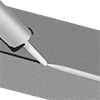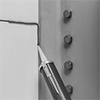Filter by
Container Type
For Use On
For Joining
Maximum Temperature
For Use With
Container Size
Clarity
Begins to Harden
Performance
Hardness Rating
Hardness
Environment
Export Control Classification Number (ECCN)
DFARS Specialty Metals
About Sealant Flexibility
More






































